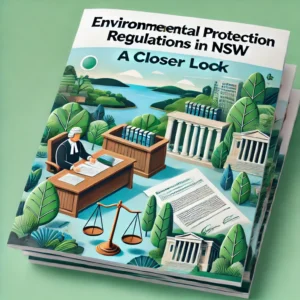Introduction
Environmental protection regulations play a crucial role in safeguarding the natural resources and ecosystems of New South Wales (NSW). These regulations aim to promote sustainable development, prevent pollution, and protect the environment for the benefit of current and future generations. This article delves into key court judgments that shed light on the principles, programs, and enforcement mechanisms underlying environmental protection regulations in NSW.
Principle of Ecologically Sustainable Development
One fundamental principle of environmental protection in NSW is the concept of ecologically sustainable development. As stated in Friends of Leadbeater’s Possum Inc v VicForests (No 4) [2020] FCA 704, this principle emphasizes the precautionary approach to environmental risks. It asserts that even in the absence of full scientific certainty, threats of serious or irreversible environmental damage should not be ignored or postponed.
Pollution Offenses and Enforcement
To prevent pollution and its detrimental effects on the environment, NSW has established strict regulations. Jali Local Aboriginal Land Council v Lois Cook [2018] NSWSC 950 highlights two key offenses under the Protection of the Environment Operations Act 1997 (NSW). Section 120 of the Act creates an offense for polluting waters, while section 142A establishes an offense for polluting the land. These provisions serve as a deterrent against activities that harm the environment.
Power of Authorized Officers
Enforcement of environmental protection regulations requires the authority of authorized officers to enter premises for investigations. Luppino v Fisher (No 2) [2019] FCA 1100 clarifies that the power of authorized officers to enter premises should not be restricted by prior notice. This ensures the effectiveness of compliance and contravention investigations related to environmental protection legislation.
Assessment of Environmental Impacts
The assessment of environmental impacts is a crucial aspect of environmental protection regulations. Santos NA Barossa Pty Ltd v Tipakalippa [2022] FCAFC 193 highlights that the Environmental Protection and Biodiversity Conservation (EPBC) Act provides a substitute decision-making process. The Regulations under this Act ensure the assessment of environmental impacts and risks associated with proposed activities, considering the social, economic, and cultural aspects of communities.
Objective-Based Regime for Environmental Management
Cooper v National Offshore Petroleum Safety and Environmental Management Authority (No 2) [2023] FCA 1158 emphasizes the importance of an objective-based regime for environmental management. The former regulations aimed to encourage industries to continuously improve their environmental performance and adopt best practices. This approach ensures that businesses operate in a manner that minimizes their impact on the environment.
Judicial Review of Environmental Decisions
The court plays a vital role in ensuring the accountability and legality of environmental decisions. Triabunna Investments Pty Ltd v Minister for Environment and Energy [2019] FCAFC 60 illustrates a case where a judicial review was sought for a referral decision made under the EPBC Act. This highlights the avenue for challenging environmental decisions and seeking legal remedies when there are concerns about compliance with environmental protection legislation.
Conclusion
The environmental protection regulations in NSW are designed to promote sustainable development, prevent pollution, and safeguard the natural environment. These regulations are guided by the principles of ecologically sustainable development, enforcement mechanisms for pollution offenses, the power of authorized officers, and the assessment of environmental impacts. Judicial review provisions ensure transparency and accountability in environmental decision-making processes. By upholding these regulations, NSW can preserve its natural resources and maintain a healthy environment for future generations.
